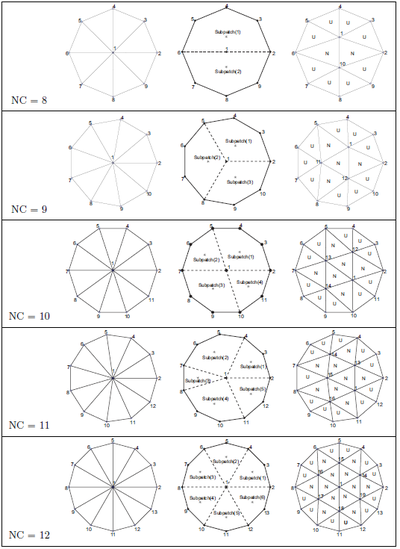SMS:Reduce Nodal Connectivity: Difference between revisions
No edit summary |
No edit summary |
||
| Line 14: | Line 14: | ||
* 12 elements - 6 new nodes added. | * 12 elements - 6 new nodes added. | ||
In each of these cases, the resulting elements all have connectivity of 6 elements. | In each of these cases, the resulting elements all have connectivity of 6 elements. The patterns of insertion are illustrated below: | ||
[[File:NewNodePattern.png|thumb|400px|left]] | |||
Revision as of 19:00, 18 December 2012
Many finite element engines (including ADCIRC) have limits on the number of elements that may be attached to a single node. When many elements attach to a single element, the node appears as a hub with many spokes radiating from it. Thus, it is termed a wagon wheel node.
When many elements are connected to a single node, each element has a smaller interior angle. This results in more severe deformations in numerical space. Ideal triangular elements have internal angles of 60 degrees. Ideal quadrilateral elements have internal angles of 90 degrees. For triangles, this would result in six elements connected (or constructed using) a single node. For quadrilaterals, at most four elements would converge at each node.
The node menu of the Mesh module includes the "Reduce Nodal Connectivity" command which inserts one or more new nodes in the area of wagon wheel nodes resulting in a maximum of 7 adjacent elements.
The command may need to be applied recursively. The first time may reduce connectivity from 12 or more to 8. Then a second application reduces connectivity to 6.
Specifically, if the current connectivity is:
- 8 elements - 1 new node added
- 9 elements - 2 new nodes added
- 10 elements - 3 new nodes added
- 11 elements - 4 new nodes added
- 12 elements - 6 new nodes added.
In each of these cases, the resulting elements all have connectivity of 6 elements. The patterns of insertion are illustrated below:
Related Topics
SMS – Surface-water Modeling System | ||
|---|---|---|
| Modules: | 1D Grid • Cartesian Grid • Curvilinear Grid • GIS • Map • Mesh • Particle • Quadtree • Raster • Scatter • UGrid |  |
| General Models: | 3D Structure • FVCOM • Generic • PTM | |
| Coastal Models: | ADCIRC • BOUSS-2D • CGWAVE • CMS-Flow • CMS-Wave • GenCade • STWAVE • WAM | |
| Riverine/Estuarine Models: | AdH • HEC-RAS • HYDRO AS-2D • RMA2 • RMA4 • SRH-2D • TUFLOW • TUFLOW FV | |
| Aquaveo • SMS Tutorials • SMS Workflows | ||
